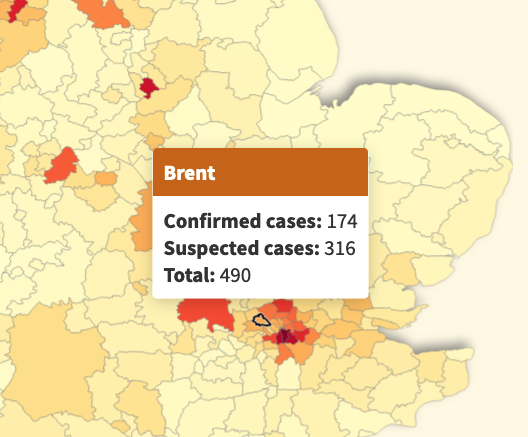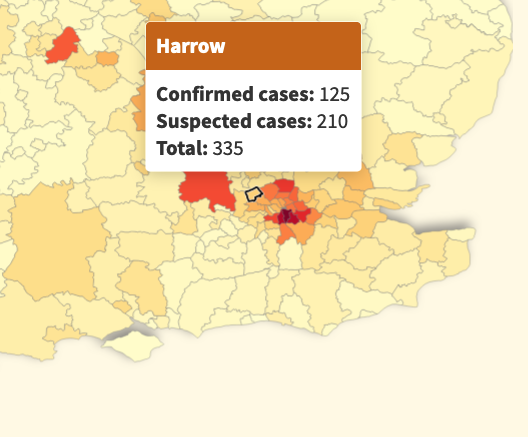Brent's Local Plan incudes designated areas for tall buildings as well as intensification corridors based on the assumption that given the shortage of land in the borough the only way to address the housing crisis is by building up and maximising high density housing on a small footprint.
Shama Tatler, Cabinet Member for Regeneration and Planningm recently short-listed to be Labour's parliamentary candidate for the Watford constituency, has been a strong advocate of such a response, even though Labour in Watford has campaigned against the Liberal Democrat Mayor's support for tall buildings.
Covid lockdown revealed problems over contagion of the virus in lifts, staircases and shared landings, as well as the lack of amenity space in which to get socially-distanced exercise in fresh air.
Problems were even worse for families with small children socially isolating in small flats, particularly on upper floors.
Alongside this has been the post-Grenfell cladding crisis which has plunged many into debt as well as anxiety, paying not only for repairs but also for fire-watches. People with disabilities have found themselves in the middle of conflicting advice over 'stay put' policies as well as the difference of opinion over the efficacy of PEEPs (Personal Emergency Evacuation Plans) supported by the London Fire Brigade but opposed by the government. Readers may recall the long-running saga of South Kilburn resident John Healy's attempts to get a PEEP from Brent Council.
Then there is of course the problem of the amount of truly affordable housing in new developments with Brent Council's insistence on terming Shared Ownership affordable.
Finally academic reports question the energy efficiency of tall buildings when many local authorities, including Brent, have declared a Climate Emergency.
Not limited to tall buildings is the emerging issue of uncapped energy prices for residents whose homes are connected to a District Heating Network. Some relief was promised while all eyes were on Boris Johnson wriggling on a hook of hs own devising, when the government announced. 'We will ensure families living on Heat Networks are better protected. By appointing Ofgem as the new regulator for Heat Network in Great Britain, we will ensure customers get a fair price and a releaible source of heat.'
Hear Martin Lewis' alarming Channel 4 piece on likely fuel bills in October HERE .
Whether this will be progressed amidst current political turmoil remains to be seen. The government has published a Fact Sheet HERE
It is against this background the the Liberal Democrat councillor for Alperton, Anton Georgiou, ask Shama Tatler a written question ahead of Monday's Council Meeting.
Readers can judge for themselves the adequacy of Cllr Tatler's written response and hear any further discussion on the Council's livestream starting at 6pm on Monday LINK:
Question from Councillor Georgiou to Councillor
Tatler, Cabinet Member for Regeneration & Planning.
Five years on from the Grenfell Tower disaster, which highlighted to many the safety
issues associated with tall buildings, developers with issues in their existing
stock (including in Brent) continue to be let off the hook. With building regulations
still nowhere near clear enough, what assurances can the Cabinet Members for
Regeneration & Planning, give to residents that:
· Tall
buildings are safe for local people?
· Tall
buildings are suitable as family homes, particularly for young children?
· About the
number of families (including how many) Brent currently place in
flats above the 5th floor?
· In view of
the 2019 UCL (University College London) study into the energy efficiency of
such buildings that allowing so many buildings, higher than 6 storeys, is not
making the Climate Emergency in Brent much worse?
Response:
Safety of Tall buildings
The Building Safety Act 2022 contains a series of reforms to building safety
and is the most substantial legislative response to the Grenfell Tower fire of
2017.
A Building Safety Regulator (BSR) has been established within the Health and Safety
Executive (HSE). Their role relates to buildings with 7 or more storeys or that
are 18 metres high and have at least two residential units, or are hospitals or
care homes. These are known as higher risk buildings (HRB).
The BSR is likely to rely relies (sic) on council building control services
(and fire and rescue services) to deliver the building control regulations for
HRBs, which is expected to involve multi-disciplinary teams.
The BSR has three main functions:
(1) To implement a new regulatory regime for higher-risk buildings, and
to be the building control authority for these buildings. This includes
building work on existing HRBs and enforcing the regime in terms of their occupation,
as well as new HRBs. The BSR looks at all aspects of the Building Regulations
not just fire related provisions. The BSR uses a multi- disciplinary team,
which is likely to include local authority building control teams. There are
three gateway points where details must be approved before progressing to the
next stage:
· planning
gateway (in place since August 2021); the planning application must demonstrate that fire safety requirements have been considered and incorporated into the construction proposals;
·
construction – pre construction, the regulator must approve the design as compliant with the building regulations;
· completion
– at pre-occupation stage, a completion certificate will only be issued by the BSR once they are satisfied that the work is complaint with
the building regulations.
Only once Gateway three has been passed (either for partial or full completion)
can the new building be registered with the Building Safety Regulator for occupation.
The BSR will then be responsible for carrying out checks to ensure that the
people responsible for managing HRB’s are managing Building Safety risks,
complying with their duties and keeping residents safe through the Building Assessment
Certificate process.
(2) To oversee the safety and performance of all buildings. This involves collecting data on the performance of local authority building control services, and external approved inspectors.
(3) To support the competence of those working in the built environment industry, and to manage the register of accredited building inspectors. This involves establishing an industry led competence committee and establishing competence requirements for building control professionals
(who need to be in place when the system becomes operational). Brent Building Control will ensure it complies with the requirements.
The BSR will be responsible for holding local authorities and building
inspectors to account, with the power to suspend or remove inspectors from the
register where necessary.
The Fire Safety Act 2021 became law in April 2021. It introduced changes to
fire safety law for buildings containing two or more sets of domestic premises
in England and Wales. The aim of the Fire Safety Act is to clarify who is
responsible for managing and reducing fire risks in different parts of multi
occupied residential buildings. It has introduced new fire safety obligations
to some leaseholders, building owners and managers for the building structure, external wall, common parts and doors
between domestic premises and common parts.
Suitability of Tall buildings as family homes
Fire safety requirements are for all people and
types of household not just families with young children. The above sets out
details on the changes that are being implemented.
Number of families Brent currently place in flats above the 5th floor
According to our household records there are 179
children across 108 households living on the fifth floor or above. These 108
households sit across 31 blocks.
Energy efficiency of buildings and impact on Climate Emergency in Brent
Both the London Plan and Brent Local Plan have been
the subject of Sustainability Appraisals and in themselves include a range of
policies to ensure that development including tall buildings respond to climate
change and environmental efficiency requirements. Brent Policies for example
include minimising greenhouse gas emissions, energy infrastructure, urban
greening and sustainable drainage. Tall
buildings allow for an effective use of land in highly accessible locations and
have advantages of minimising car travel and support infrastructure being
delivered in a sustainable way such as waste management and energy.










